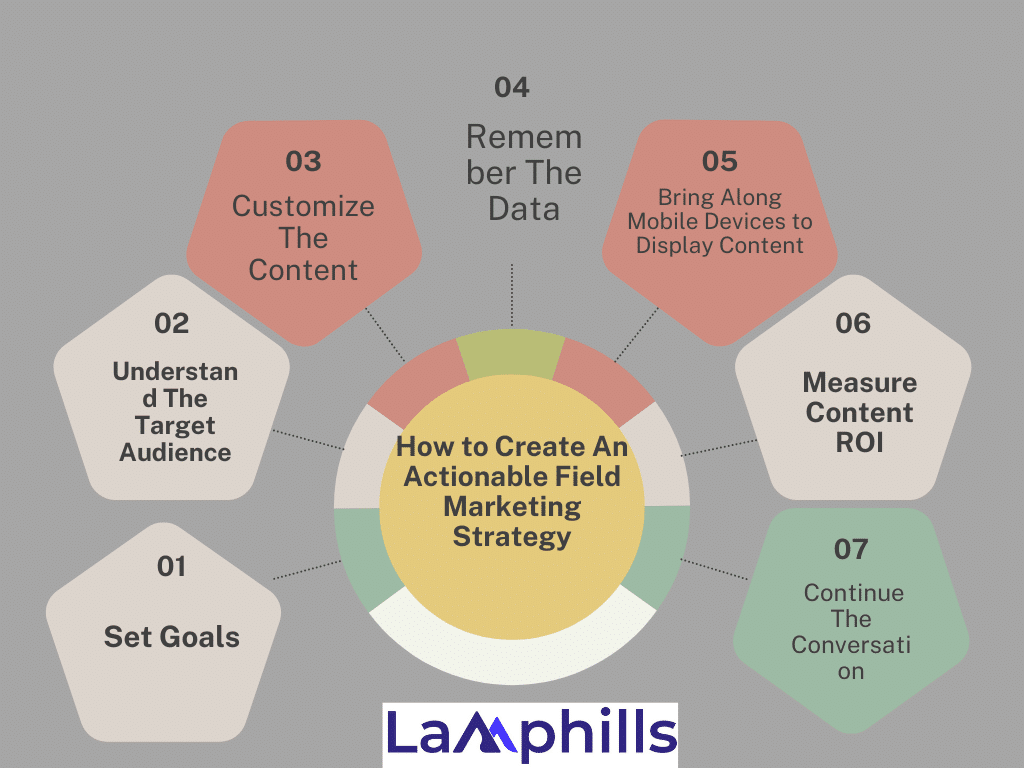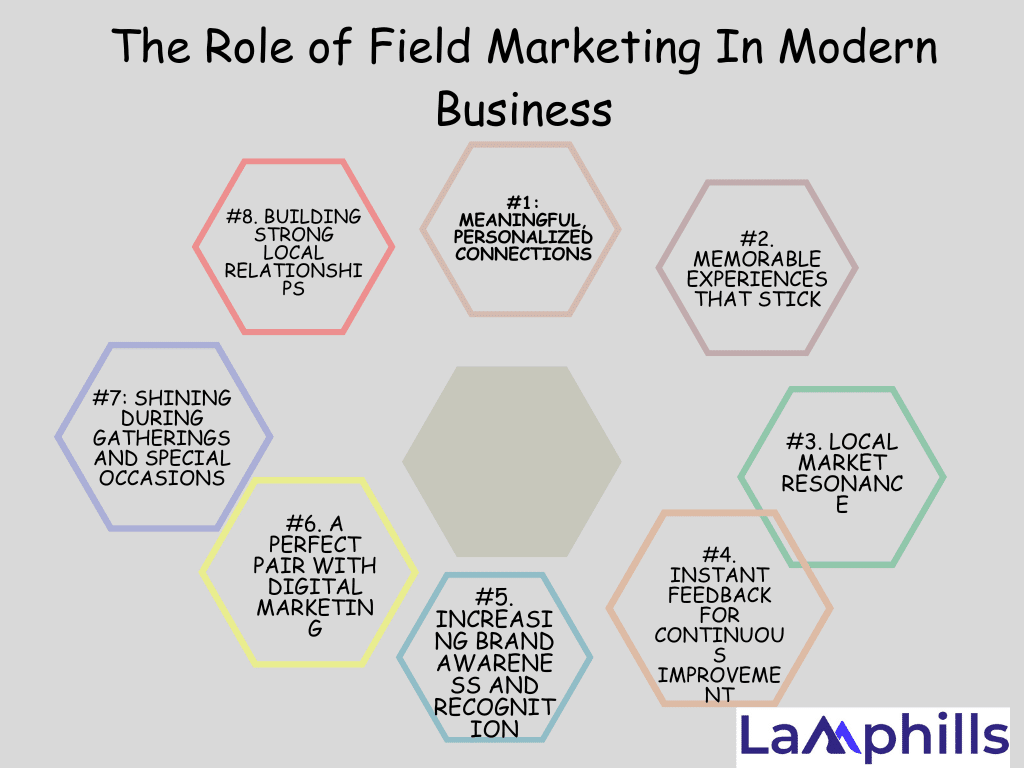Field marketing is an effective marketing method that complements a larger brand marketing plan. Its goal is to raise brand awareness in the community through in-person interactions. In today’s age of digital commercials, social media ads, and influencer endorsements, field marketing may appear to be a relic of the past. Despite this digital takeover, there is something irreplaceable about face-to-face communication.
In 2024, as consumers become more accustomed to online commercials, field marketing provides a refreshing method to communicate personally with your target demographic. And believe me, it works. I’ve seen firsthand how a well-executed field marketing plan can elevate an average company to household recognition. In this article, I’ll show you how to use this powerful tool to build stronger customer connections and make your brand unforgettable.
Key Takeaways
- Field marketing combines push-pull strategies to create deeper relationships, using human interactions to drive attention, interest, desire, and action (AIDA), which is critical for building brand loyalty and generating sales.
- One of the greatest strengths of field marketing is its ability to tailor approaches to resonate with local markets, creating personalized experiences that align with regional cultures, preferences, and behaviors.
- Field marketing offers immediate feedback through direct customer interactions, which provides valuable insights for optimizing products, services, and future marketing strategies.
- Modern field marketing integrates technology such as mobile devices and augmented reality, making it easier to showcase products, collect customer data, and measure the return on investment (ROI) from personalized in-field experiences.
What is Field Marketing?

Let’s begin with the basics. Field marketing means getting out there and putting your product into the hands of your target audience in person. This can include in-store demos, sample sessions, or even pop-up stores. It’s about providing a tangible, in-person experience that no internet ad can match.
You may be thinking: “Why should I prioritize field marketing when digital marketing offers such high returns?” Here’s the solution: human connections. Field marketing offers closeness, but digital platforms offer scale. In a day where clients crave authentic interactions, field marketing delivers by fostering relationships through direct, human contact.
Field marketing is a tactic used by highly trained people to establish brands, and consumer relationships, and generate leads for a client or company. It’s a measurable process and typically involves face-to-face interactions with leads and customers.
In addition, field marketing is a practical application of the AIDA (Attention, Interest, Desire, and Action) principle. Field marketing activities are intended to capture the target audience’s attention, generate interest in and desire for your services, and, ultimately, drive action, i.e., sales.
Explaining Field Marketing Activities

Field marketing activities include five major disciplines that I will explain below:
#1. Sales
Highly trained salespeople locate, comprehend, and engage in communication with the target audience to sell to. This field marketing activity is typically carried out during events with a large turnout of the brand’s target market. Brands frequently delegate this task to field marketing companies so that they can focus on their core business.
#2. Merchandising
Merchandising is the arrangement of marketing materials (such as posters and shelf barkers) in a retail setting. It also encompasses:
- Developing a relationship and rapport with the retailer.
- Ensuring that products are well stocked, captivatingly displayed, and vigorously promoted.
- Measuring and evaluating the performance of the brand within the retail outlet.
#3. Auditing
Auditing is the collection of data on a brand’s standing in the marketplace. A field marketing audit examines how a brand and its competitors are dispersed among and within retailers. It also assesses how products are displayed by mapping stock levels, facings, and order sizes.
Auditing aids in the development of a strategy for future marketing and field marketing efforts. With real-time reporting capabilities, the auditing process has become more efficient and less tiresome.
#4. Sample And Demonstrate
During this FM activity, a field marketer either demonstrates how a product works to the consumer or lets the client try/taste it. This activity is most effective when a targeted client chosen for sampling and demonstration has the potential to be a brand ambassador. These brand ambassadors are usually people who can influence more sales by showing the brand in a positive light and discussing it within their social circle.
#5. Experiential Marketing, Events, And Roadshows
The DMA defines experiential marketing as “a live and interactive marketing discipline that builds positive emotional and sensory engagement between a brand and its consumers.” Although any field marketing action allows customers to interact with a brand, this particular activity is associated with excitement, engagement, and entertainment.
Field marketing, which includes events and roadshows, fosters an emotional connection between the customer and the company. These outdoor marketing initiatives, whether individual or combined, help to establish brands and provide a meaningful return on investment for the organization.
Field marketing activities are aligned with marketing objectives that will be met through their implementation. They assist in drawing attention to a product/solution/brand at a certain time when customer awareness and experience with a brand might be influenced.
How to Create An Actionable Field Marketing Strategy

So your target market is B2B, necessitating a distinct field marketing strategy. As a result, I’ll cover both traditional field marketing techniques and cutting-edge approaches.
#1. Set Goals
Companies frequently fail to plan or execute successful field sales. In many cases, there is no connection between the product’s other marketing and sales techniques. Field sales methods are most effective when they are in sync with what sellers are doing in their specific area.
One key to being successful with a field strategy is establishing goals. There are several questions that companies may wish to consider when setting these goals:
- What’s the target audience?
- Is this audience currently aware of the brand?
- What’s the conversion goal?
- What talking points are likely to drive sales?
#2. Understand The Target Audience
You must first identify your target audience. Who would benefit the most from your product or service? Once you’ve identified them, arrange your field marketing events in areas where they already congregate, such as a concert, shopping mall, or even a college campus.
Any field strategy’s success is determined by the brand’s ability to connect with its target audience. Hence, companies must first understand their target audience to succeed. When it comes to marketing in this industry, firms are tempted to adopt a wide strategy. Companies that focus their marketing efforts on their target demographic improve their brand positioning and marketing success. This may necessitate market research to map the target audience. The investment into properly understanding the target audience is likely to prove a prudent one in the long term.
#3. Customize The Content
Businesses can concentrate on the marketing initiatives that yield the highest return on investment by closely monitoring their target demographic. This could entail creating content that is tailored to each target audience category for the brand. A cost-effective method of customizing is to create a set of templates that are simple to modify to fit each segment. It’s important to take the time to think through the kinds of events that best fit each audience segment if a firm wants to host a number of them as part of its field selling strategy.
#4. Remember The Data
It’s a common misconception that marketing in the field doesn’t generate data to evaluate the success of the various activities. In reality, all marketing activities have the potential to generate data. With field selling, this often means the company has to redefine how it gathers its marketing data.
#5. Bring Along Mobile Devices to Display Content
Since everyone is tech-savvy these days, you must incorporate technology into your field marketing campaigns. Utilize augmented reality (AR) to improve the customer experience, integrate social media hashtags during events, and employ mobile apps to gather customer data. Every product sample in the campaign I oversaw for a beverage company featured a QR code that brought consumers to a website where they could get more details and a deal. It operated flawlessly.
It’s simpler to promote your goods and services when you use smartphones and tablets. You can utilize these gadgets as digital marketing assets to offer relevant content. This allows for the instant delivery of customized experiences. Additionally, field marketers use mobile devices for lead generation (i.e., quickly sign up an attendee to a newsletter to receive gated content).
#6. Measure Content ROI
It is simpler to assess the return on investment of the content when digital marketing materials are included. In the field, for example, participants can interact with PowerPoint presentations, case studies, films, brochures, pictures, and more. Since they are all trackable, success can be easier to keep an eye on. Examine which content converts and closes deals, then work to replicate that success. These comments can be quite helpful.
#7. Continue The Conversation
What do you do once the field marketing campaign is concluded? Moving on to the next campaign will cost you the chance to build on the accomplishments of the last one. You struck up a discussion with potential clients, so why not keep it going? In doing so, you can grow the discussion to include more possible leads. At the same time, you’re increasing your visibility, trust, and reputation. Social media is a great platform to transfer “in the field” conversations to the digital world.
Types Of Field Marketing Strategies

Here’s where field marketing gets fun. There are countless ways to execute a field marketing campaign, but here are a few tried-and-true methods that never fail to create lasting impressions.
#1. Product Demonstrations
When you were in a grocery shop, did you ever receive a sample at no cost? It is the epitome of field marketing. Events with sampling provide prospective buyers a risk-free opportunity to try your product. Free stuff is popular, so it makes sense.
Field marketers utilize booths or stations to exhibit and illustrate the characteristics and advantages of their products in retail stores, trade exhibitions, and events. Engaging with prospective clients, they respond to inquiries and promote trial or buy.
A field marketing favorite is product demos. Here customers can taste your products and services in an ideal setting and receive individual presentations. Using this, B2C businesses can ask questions in busy places like malls. customers to try out their products. B2B companies use product demonstrations at conferences and trade shows where they’re likely to meet the most relevant audience.
#2. In-Store Promotions
There’s nothing like engaging customers directly at the moment of purchase. In-store promotions allow marketers to influence purchasing decisions while customers are in the market to buy. When we first established a coffee company a few years ago, we held demos in local stores, and the immediate feedback (and purchases!) from eager customers was invaluable.
Field marketers work with retail partners to develop in-store promotions, such as product displays, discounts, or giveaways, to attract customers and boost product visibility. They may also teach shop staff to ensure they have the requisite product expertise.
In-store promotions take a different strategy to promoting in-person sales than product demonstrations. In this scenario, field marketers seek to increase sales by encouraging customers to make related purchases.
You see this strategy in home improvement stores like Lowe’s or Home Depot—where you might find a sales rep offering services like window or roofing installations to customers based on the types of products they’re working on.
Typically, the goal here is generating leads for a high-consideration service—whereas, with product demos, the goal is to get consumers to try a new snack so that they might make it part of their grocery list.
#3. Experiential Marketing Events
This checklist below covers every stage of an experiential marketing event, from initial brainstorming to post-event follow-up, ensuring that no detail is overlooked.
This is where creativity comes in. Pop-up stores and experiential marketing events are intended to fully immerse customers in your brand. A friend of mine once organized an immersive marketing campaign for a tech company that included interactive demo stations in unexpected locations such as airports. The surprise element, along with the hands-on participation, was a big success.
Brands host experiential events or activations in public locations or venues to provide consumers with memorable experiences. This could be pop-up stores, brand-sponsored events, interactive installations, or immersive experiences that allow customers to connect with the brand directly.
#4. Street Team Campaigns
Street promotions typically involve sending teams of marketers into high-traffic areas to distribute free samples, flyers, coupons, or other incentives related to the event experience. This style of marketing often includes the distribution of samples, similar to the product demonstration technique, but it is more concerned with improving the experience and brand perception. Field marketers organize street teams to interact with individuals in high-traffic areas or specified target places. They hand out samples, promotional information, or coupons, and engage in conversations to raise brand awareness and generate leads.
#5. Trade Shows And Conferences
Companies participate in trade shows and industry conferences to showcase their products or services to a targeted audience. Field marketers manage the booth, engage with attendees, give presentations, and gather leads.
#6. Guerilla Marketing
Field marketers use innovative and eye-catching strategies in public places to generate buzz and brand exposure. Flash mobs, street art, interactive exhibits, and inventive stunts are all examples of ways to engage pedestrians and inspire them to share their experiences on social media.
Guerrilla marketing is the growth hacking aspect of field marketing. A creative guerrilla marketing campaign has the potential to generate buzz and increase word-of-mouth among your ideal buyers. This strategy uses inventive or innovative acts to capture the audience’s attention in a short time, such as IKEA decorating subway stations with couches.
#7. In-Person Events
Given the in-person character of most field marketing efforts, events are well-known instances of field marketing in action. Keep in mind that, despite the similarities, field marketing is not the same as virtual event marketing because the major focus is slightly different in each function. Event marketers are solely responsible for promoting and carrying out event-related campaigns before, during, and following the event.
Field marketers, once again, focus on discovering relationship-building opportunities based on specific sales and marketing goals. This can include hosting events, participating in large events such as Salesforce’s Dreamforce, or attending niche-specific trade shows.
#8. Sponsorship Activities
Field marketers use sponsorship opportunities, such as sporting events or music festivals, to engage with attendees and promote the brand. They may set up branded booths, organize contests or games, offer giveaways, or host VIP experiences.
The Role of Field Marketing In Modern Business

Field marketing can be extremely significant in many firms. It has various advantages for businesses trying to leave a lasting impression and establish strong client relationships. Here are some important benefits of implementing field marketing into your entire marketing strategy:
#1: Meaningful, Personalized Connections
Field marketing allows you to build genuine connections with your target audience by connecting with them face-to-face. This personal touch promotes trust, credibility, and a stronger – and more lasting – emotional bond with your brand.
#2. Memorable Experiences That Stick
Field marketing delivers the remarkable encounters that clients remember. You know when you go to an event or a business and the cheerful personnel throw out samples and talk about the products? That is field marketing at work! Whether through interactive product demos, immersive brand activations, or engaging discussions, these real-world experiences may greatly improve brand memory and word-of-mouth marketing.
#3. Local Market Resonance
One of the advantages of field marketing is its adaptability to local markets. Field marketers can adjust their strategy, messaging, and strategies to the cultural nuances, tastes, and behaviors of the target population. This level of localization can dramatically improve the effectiveness of your advertising.
#4. Instant Feedback For Continuous Improvement
Unlike traditional marketing channels, field marketing enables you to get immediate feedback from your clients. You may have two-way conversations, listen to their views and concerns, and get vital information that can inspire product development, service changes, and future marketing plans without waiting for online surveys – everything is real-time and actionable!
#5. Increasing Brand Awareness And Recognition
Field marketing enables organizations to create a statement in new markets where their brand may not be well-known. They can increase brand exposure and familiarity by going out and displaying products and services in real-world settings.
#6. A Perfect Pair With Digital Marketing
While field marketing emphasizes in-person encounters, it can be smoothly linked with digital marketing initiatives. You can use social media, augmented reality, and other digital technologies to boost your field marketing initiatives, resulting in a multichannel experience that reaches a larger audience.
#7: Shining During Gatherings And Special Occasions
Field marketing is particularly effective during events such as trade exhibitions and product launches. These events provide an excellent opportunity for firms to showcase their products, pique people’s interest, and make a lasting impression. B2B marketing event strategies: before, during, and after.
#8. Building Strong Local Relationships
Field marketing is more than just selling items; it’s about becoming a member of the community. Field marketers develop close ties with locals and become trusted members of the community. It’s not just about making sales; it’s about building long-term loyalty and advocacy. Measurable outcomes: Field marketing programs can be tracked and measured using a variety of measures, including lead generation, sales statistics, customer involvement, and brand awareness surveys. This data-driven approach enables you to assess the impact of your field marketing efforts and make informed decisions about future initiatives.
What is the difference between marketing and field marketing?
Field marketing takes place at Point-of-Sale, during events, conferences, exhibitions, etc. Digital marketing is through digital media such as ads, blogs, websites, and promotions. Field marketing is done face-to-face with customers, such as freebies, handouts, etc.
What is another name for field marketing?
It is event marketing.
What is field marketing in B2B?
Field marketing allows B2B companies to engage with potential clients on a personal level.
Final thoughts
Field marketing is all about making real connections that count. It’s about getting out there, rolling up your sleeves, and engaging with your audience on a personal level.Sure, digital marketing has its place, but there’s something special about face-to-face interactions that can’t be replicated online.
With field marketing, you’re not just promoting a product—you’re creating experiences that stick. You’re building trust, gathering invaluable feedback, and becoming an active part of the community. It’s a powerful approach that can supercharge your brand awareness, customer loyalty, and growth.
In 2024, field marketing remains one of the most powerful ways to create strong customer connections. Whether you’re sampling products, hosting pop-up shops, or sending out street teams, the ability to engage with customers face-to-face is irreplaceable. So, next time you’re planning a marketing campaign, consider stepping away from the computer screen and getting out there to connect with your audience. You might be surprised by the results!





